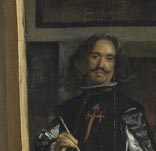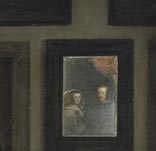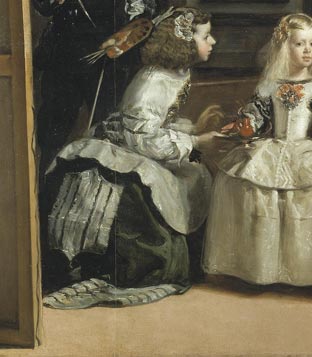 |
 |
 |
 |
||
 |
 |
 |
|||
 |
 |
||||
 |
 |
 |
 |
||
 |
 |
 |
|||
 |
 |
||||
Medium
Las Meninas (The Maids of Honor) was completed by the Spanish painter, Diego Velazquez, in 1656. The 318 cm × 276 cm canvas oil painting currently resides in el Museo Del Prado in Madrid. The painting was originally catalogued as La Familia (The Family).
In recent years, the painting has faded, specifically there has been a significant loss of white and blue hues due to pollution from crowds of tourists who flock through the Prado. Here a cropped version of the original is displayed. To see the picture in its entirety, please click here.
One of the many reasons this painting has become famous is because of its unique perspective. The many figures portrayed in the painting all carry significant messages and ideas to the viewer, yet the content of these messages has been heavily debated over the years. The most common debate over Las Meninas is between reality and illusion. The mirrored portrait of King Philip IV and his wife Mariana of Austria is just one example of an image that sparks the reality versus illusion debate.
The ambiguous nature that pervades every relationship in this picture is part of what has made Las Meninas so famous. The relationship between the viewer and most of the subjects in the painting is questionable due to their seemingly fixed gaze on the viewer. Who were they supposedly looking at? Could it perhaps have been the royal King and Queen who are pictured in the mirror? Their seated placement in the mirror lends credence to the possibility that they were in observation of the entire scene. Also, is the man in the doorway coming or going? It was undoubtedly Velazquez's intention to create such a painting where careful observation only gives way to more questions.
Dwarfism was common amongst people in the 17th century. The smaller dwarf pictured is a male Italian dwarf named Nicolas Petusato. The taller achondroplastic female dwarf, Maria Barbola, is of German decent. The emphasis of their unique features in Las Meninas is unmistakbly significant.